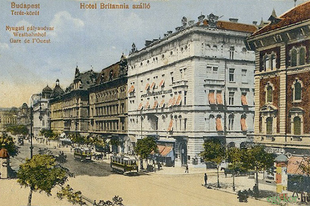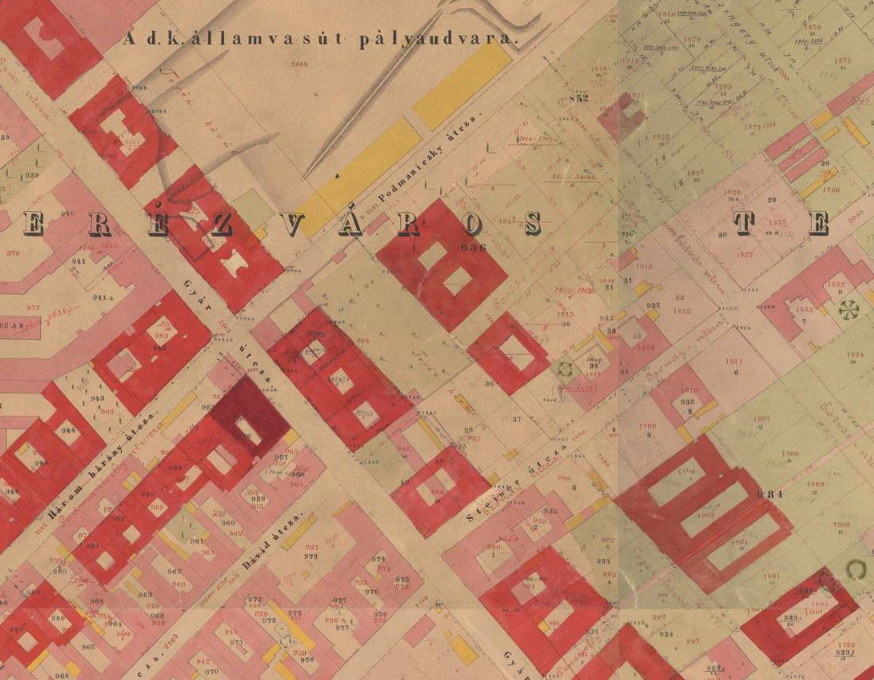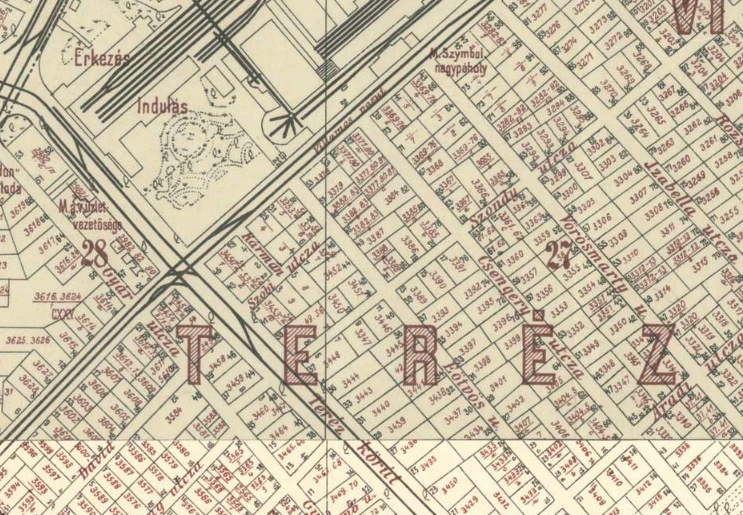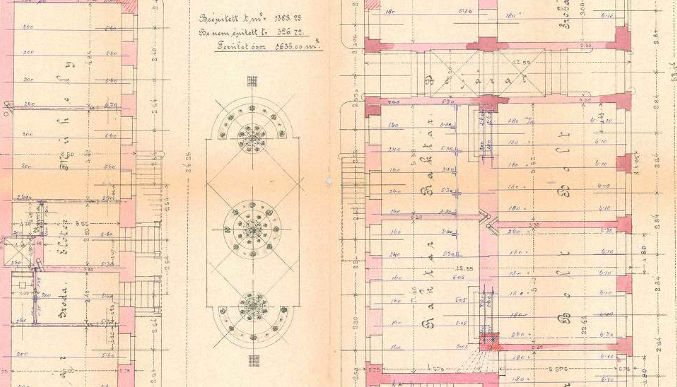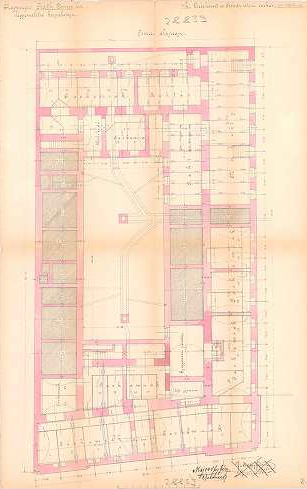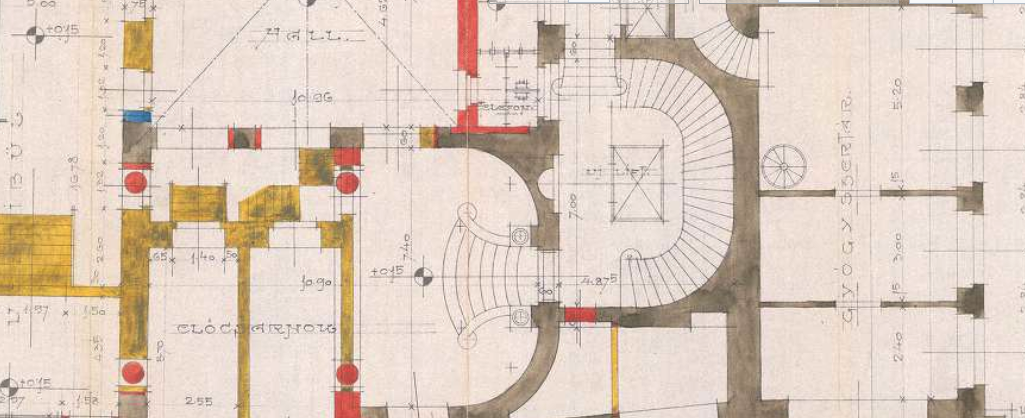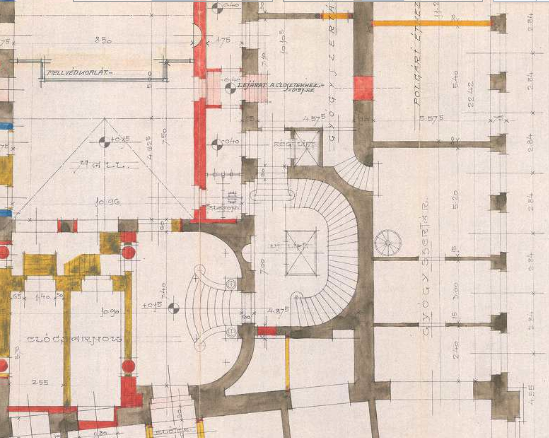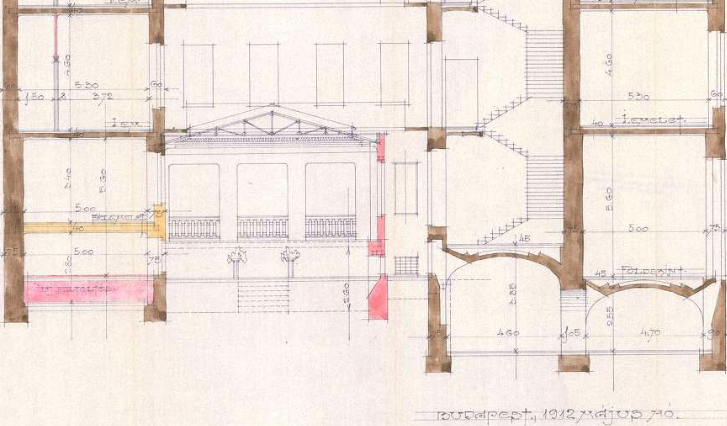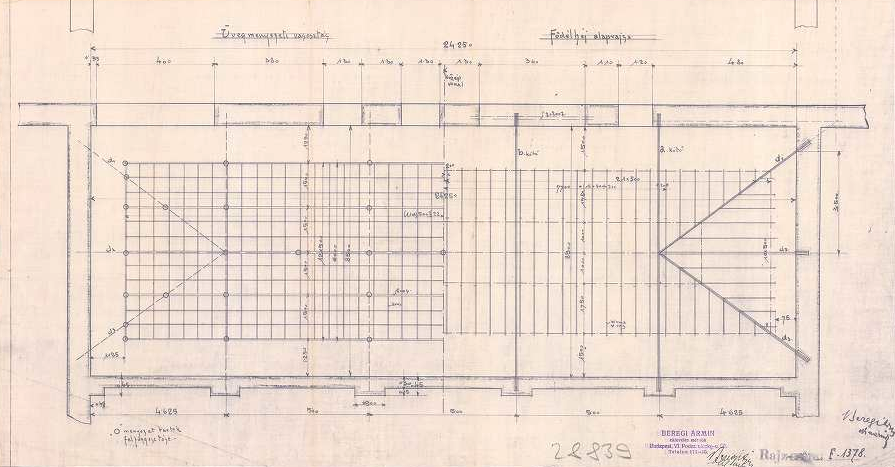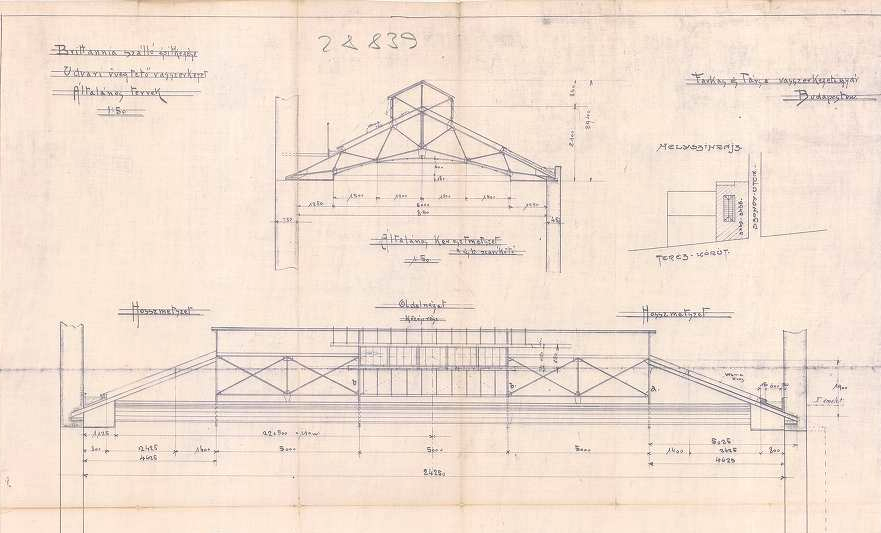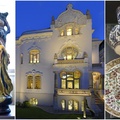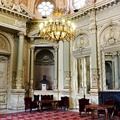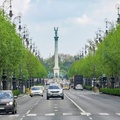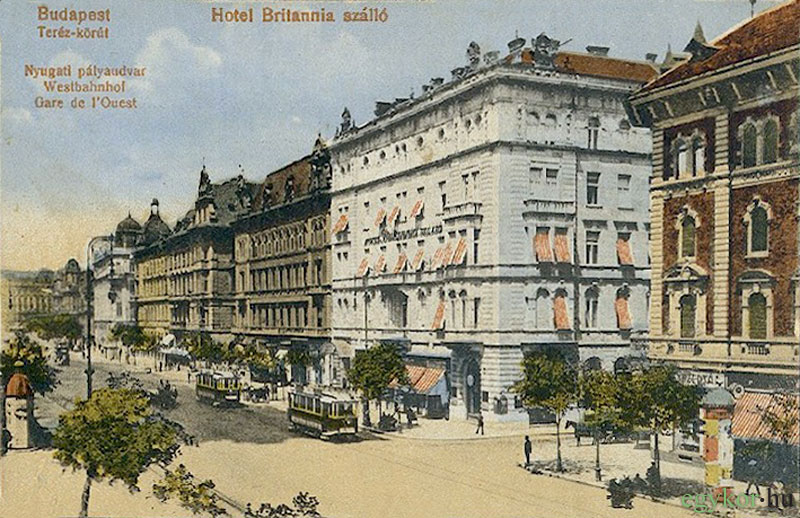
When you look at an older building, do you know anything about its origins or the vision its architect had in mind? I have already showed you the Budapest Time Machine, which helps you look into the past of a building or a part of the city. In this post I share the blueprints of a special hotel, still in business today, with its openable dome adored by everyone.
The history of Hotel Britannia from its opening in 1913
While digging deep into the databases of the Budapest Time Machine I found the complete project documentatioof Hotel Britannia, about 60 blueprints including the construction drawing of the openable dome.
At the end of the 1800s there were not many mansions in the so-called outer Terézváros area, and cafés were quite rare as well. As art historian, Noémi Saly said “the section between Aradi Street and Szondi Street with all of its ten mansions was the longest continuous line of houses, and there were not a proper corner to be found for a café. There were of course attempts: the wife of Ede Burger opened a café in 1896 under number 31, in 1890 Hermann Weis followed her example a few houses down, while on the corner of Szondi Street, János Gebauer, famous in Ferencváros, attempted to start a café as well, but none of these ere in business for more than a year, with very little success.”
In the three contemporary pictures we can witness the development of the area: In 1872 there was no boulevard yet, but the location of the railway station is visible. It was expected that around the Western railway station (Nyugati pályaudvar) there would be demand for a hotel.
From the blueprints we can see that during its construction in 1896, the building of Hotel Britannia was not meant to be a hotel but a mansion. The building on the corner of Teréz Boulevard and Szondi Street was originally an apartment block designed for János Ráth. And that is not all! Although the two buildings have melted together, in 1884 Szondi Street 12 was a separate one-story building as well. Later you will see, that the ground floor of this building became the Dome hall, Wedding hall, cold kitchen and storage place of the hotel.
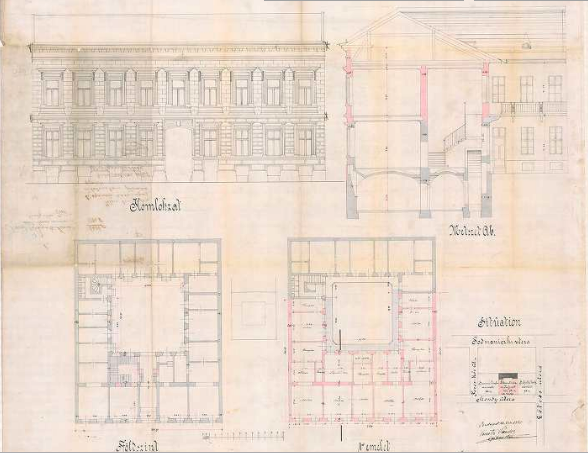 The apartment building on Szondi Street 12 has the same topographical lot number in the database but over a 100 years ago it was a separate building. It was designed in 1884.
The apartment building on Szondi Street 12 has the same topographical lot number in the database but over a 100 years ago it was a separate building. It was designed in 1884.
The frontal design of the apartment block commissioned by Mr. János Ráth in 1896. This mansion was bought and transformed by Henrik Fábri, café owner, who saw potential in opening a hotel.
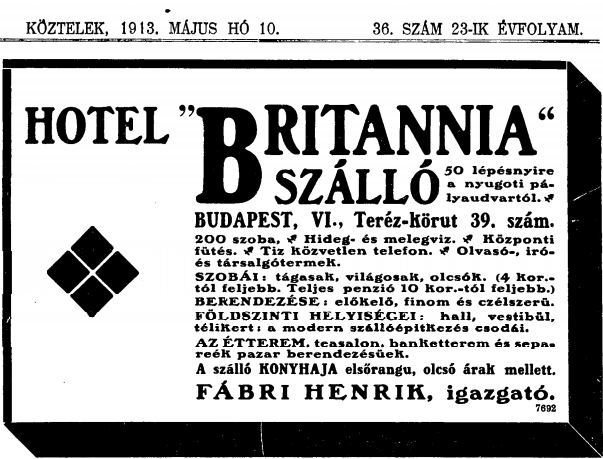
The exclusively modern Hotel Britannia became widely known in May 1913, especially since the only other accommodation in the area was the outdated London Inn, which stood no chance against the new hotel. As the advertisement above illustrates it, Director Fábri did his best and carried out a huge investment.
The hotel was meant to be full of luxury, so they used the most modern solutions: central steam and water heating was provided and each room had cold and warm running water. Twelve rooms had en suites! Like the Astoria Hotel, the Britannia also had its central vacuum cleaner, beside its own laundry, and a room service system operating with light indicators. The hall was decorated with wood paneling and bronze chandeliers, and a double course, prismatic, polished glass roof, so the restaurant set up below was brilliantly illuminated night and day.
The marble staircase still stands there in the hall of the Radisson Blu Béke Hotel
On the blueprints the new name (Hotel Britannia) and the date (1912) are clearly visible. It is worth to take a closer look at the blueprints! We can discover, for example, the same marble staircase which stands unchanged in the Radisson Blu Béke Hotel, the successor of the Britannia.
The Hotel Britannia and its restaurant embodied the leading example of the era; it excelled at the comfort provided and at the dance events organized on Sundays alike.
“We dined in the Britannia” begins the account of an evening in the past century, published in the journal Színházi Élet (Theatre Life), 1929/42. issue, “[...] waiters in tailcoats silently glide among the tables, where the best company of Budapest and Hungary are seated. In one of the banqueting halls designed by wonderful craftsmanship and taste, there is a wedding celebration going on. Sometimes, as the quick waiters fling the door open, we catch a few snippets of a joyful toast. As it is vintage time, one could say that there is a wedding in Britannia every day. The restaurant of Britannia, just like its bridge room, is very fashionable these days, as every night this is where born aristocrats, the socialites of Pest and the representatives of the country folk visiting Pest, all meet” says the journal.
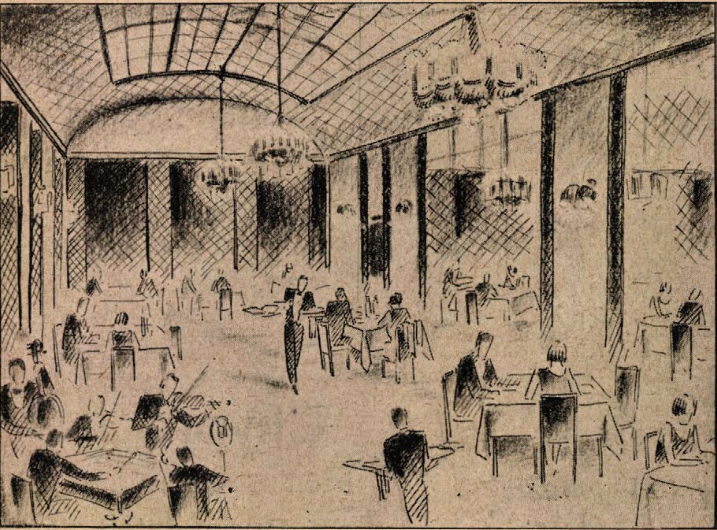 The former restaurant of Hotel Britannia.
The former restaurant of Hotel Britannia.
Annak ellenére, hogy a szálló kivívta a vendégek elismerését, Fábri csődöt jelentett, és ezt követően a hotel többször gazdát cserélt. A Britannia végre 1926-ban ért révbe, hála a szakmához értő, művészetkedvelő Németh Aladárnak és feleségének. Némethék - akik egyébként a szállóban is laktak - megfeleltek a kor kihívásnak; Despite the hotel gaining the appreciation of the guests, Fábri filed for bankruptcy, which was followed by several changes in ownership.
The fate of Britannia was settled in 1926, owing to Aladár Németh and his wife, who were familiar with the industry and loved arts. The Némeths, who actually lived in the hotel, could meet the demands of the era: they made the hotel profitable, and started a new, lucrative establishment within.
The café was renewed, the Dome hall, a lavish place of amusement in Budapest was established, while the Szondi tavern operated at full capacity to serve the everyday needs. Artist Jenő Haranghy’s work in Hotel Britannia is also connected to the couple.
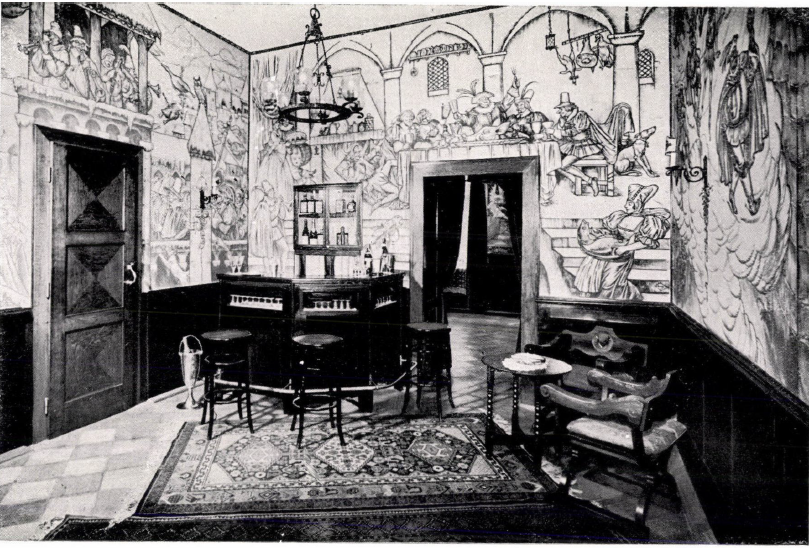
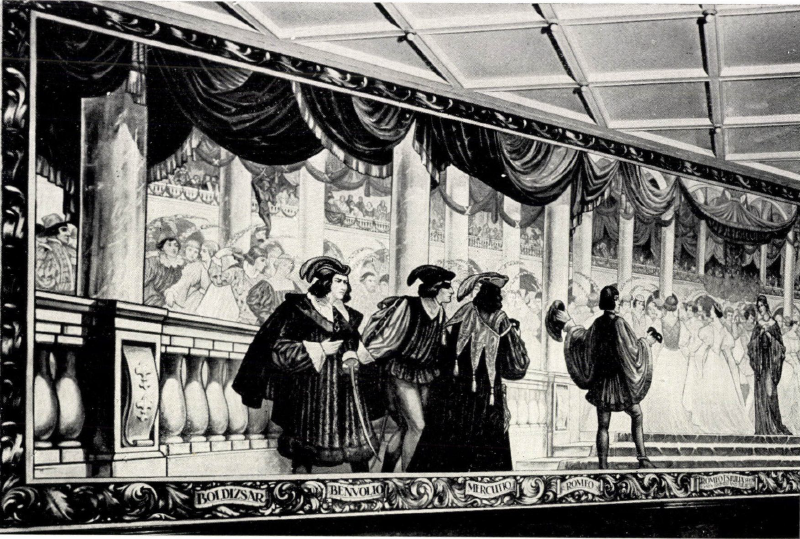 This is how in 1938 the Magyar Iparművészet (Hungarian Industrial Design) journal published the paintings from the new halls of Hotel Britannia, which were the works of Jenő Haranghy, the interior designer and artist of the hotel.
This is how in 1938 the Magyar Iparművészet (Hungarian Industrial Design) journal published the paintings from the new halls of Hotel Britannia, which were the works of Jenő Haranghy, the interior designer and artist of the hotel.
Hotel Britannia opened in 1913, leading the tourism statistics in Budapest, its illustrious guest list including land owners from the countryside, professionals, merchants, along with foreign factory owners. The hotel became more and more frequented, proving that anyone who came to visit was satisfied and had a good time. The menu was carefully chosen, I counted thirty-one appetizers in total. [...] The offer is incredibly varied, only the menu for drinks can compete with that.
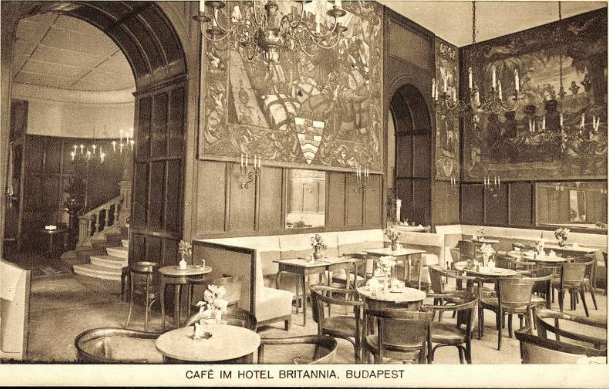 The café in Britannia was decorated with the images of coffee harvest in India and Brazil. Jenő Haranghy’s tapestry plans, to be precise, as these were never actually woven.
The café in Britannia was decorated with the images of coffee harvest in India and Brazil. Jenő Haranghy’s tapestry plans, to be precise, as these were never actually woven.
The wonder of the openable dome structure
In the 1930s, as Aladár Németh clearly understood, Budapest was in dire need of an elegant place of entertainment, with room for hundreds, since the ball room of Hotel Royal had closed and operated as the Apollo cinema since 1918.
The Dome hall was designed for over five hundred guests, and it made a grand impression. It was an astonishing experience to dance in a luxurious environment, under the starry sky, not to mention, in the garden of a mansion in Budapest. The truth is that the whole place was designed to dazzle.
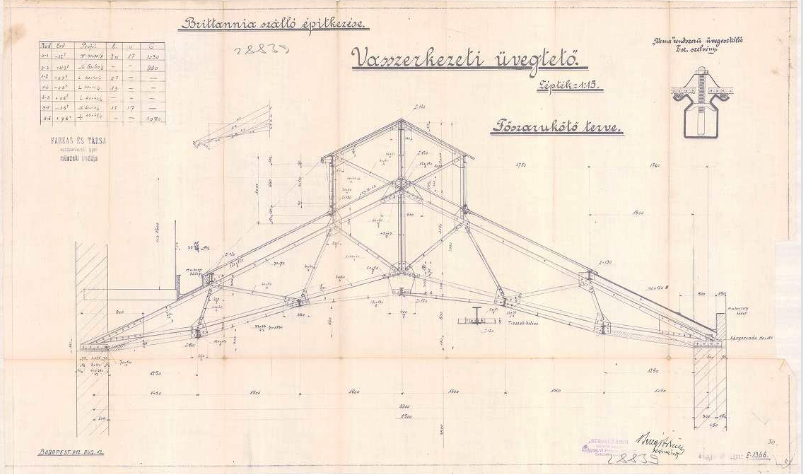 The Dome hall was named after its special roof. The round dome and the double layered glass covering were regarded as architectural virtuosities. The glass roof slid open with the push of a button.
The Dome hall was named after its special roof. The round dome and the double layered glass covering were regarded as architectural virtuosities. The glass roof slid open with the push of a button.
The Dome hall was designed by architect Márton Rácz in 1938. The openable glass roof was an architectural sensation in itself, not to mention the unique statics: the whole structure rested on green marble columns. At the same time the first underground garage of Budapest was built under the hotel, lit by the Dome hall.
Regular guests of the Britannia were used to the luxury of the Dome hall, but the citizens of Budapest were awe-struck for a long time. The fact of how often, and on what occasions was someone taken to “the dome” became a significant index for women. It was difficult to attend some of the bigger events.
Further grandiose plans were prevented by Word War II: as a matter of fact, the hotel was hit by a bomb as well. Fortunately, the original facade, which is over a hundred years old, was successfully preserved during the renovations, similarly to the Grand Hotel (Nagyszálló).
And some things never changed: we can still admire the mosaics about György Szondi on the right corner of the building—these were also created by Jenő Haranghy. The hotel and the café were renovated in 2018: since then the Zsolnay Café has a direct entrance again from the Teréz Avenue, just as Aladár Németh hotel director visualized it.
 The photo shows the heiress of the former Britannia Hotel, Radisson Blu Béke Hotel on the corner of Teréz Boulevard - Szondi Street, where the Zsolnay Cafe opens.
The photo shows the heiress of the former Britannia Hotel, Radisson Blu Béke Hotel on the corner of Teréz Boulevard - Szondi Street, where the Zsolnay Cafe opens.

